
Bettas are a very misunderstood fish. Like goldfish, they have been the object of a very concerted campaign by PETA (People for the Ethical Treatment of Animals) to stop the keeping of bettas in small containers. “A single betta requires five gallons of water minimum” has become the mantra (some say ten gallons!). That mantra is incorrect. Passionate opinion is decidedly not synonymous with scientific fact, in my not so humble OPINION.
Stocking ANY fish is just OPINION, nothing more. University researchers who raise danios by the millions for genetic research have found little negative impact even when fish are stocked at twenty times the level “recommended” for aquariums. My OPINION is that, if you have aeration, a filter and a heater, bettas are fine in very small aquariums, like even half a gallon.

The correct mantra is “Bettas need decently filtered still water above seventy degrees”. Bettas are native to small bodies of still water and still water drainage ditches in Southeast Asia. These waters are typically high in bacteria count, high in dissolved organics and low in oxygen. The betta is an anabantid fish and can breathe air. Note that just because an anabantid fish CAN breath air it does not mean they are at optimum health in turbid, oxygen-deficient water. Nothing can be further from the truth. Like all fish, bettas do best with good aeration and good biofiltration.
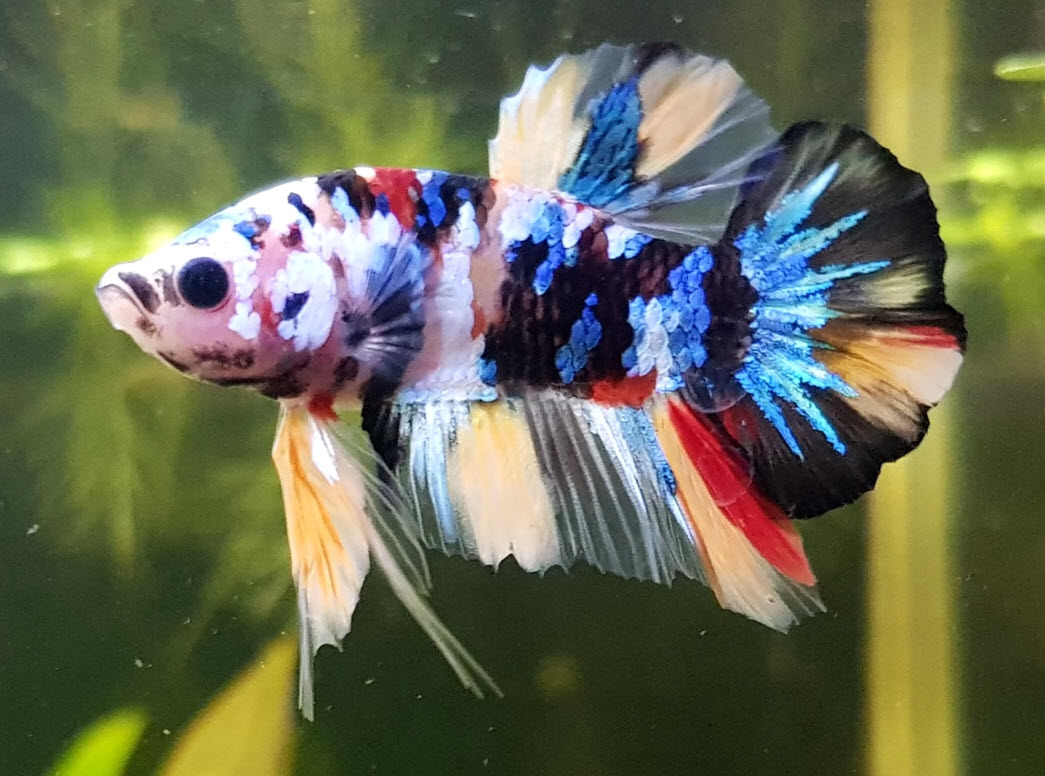
Bettas in More Depth
Bettas are fighters. Two male bettas can generally not be kept in the same tank as they will kill each other. And even a female in with a male will often be killed by the male. So male bettas are typically kept only at one betta per aquarium.
Females can be kept in “sororities” of three to twenty fish but it can be challenging. Sometimes a female will decide to become “dominant” and start fighting. Adding a single female betta to an established sorority is not recommended. Sometimes the new female will be killed. Add at least three females at a time and move everything around in the aquarium.
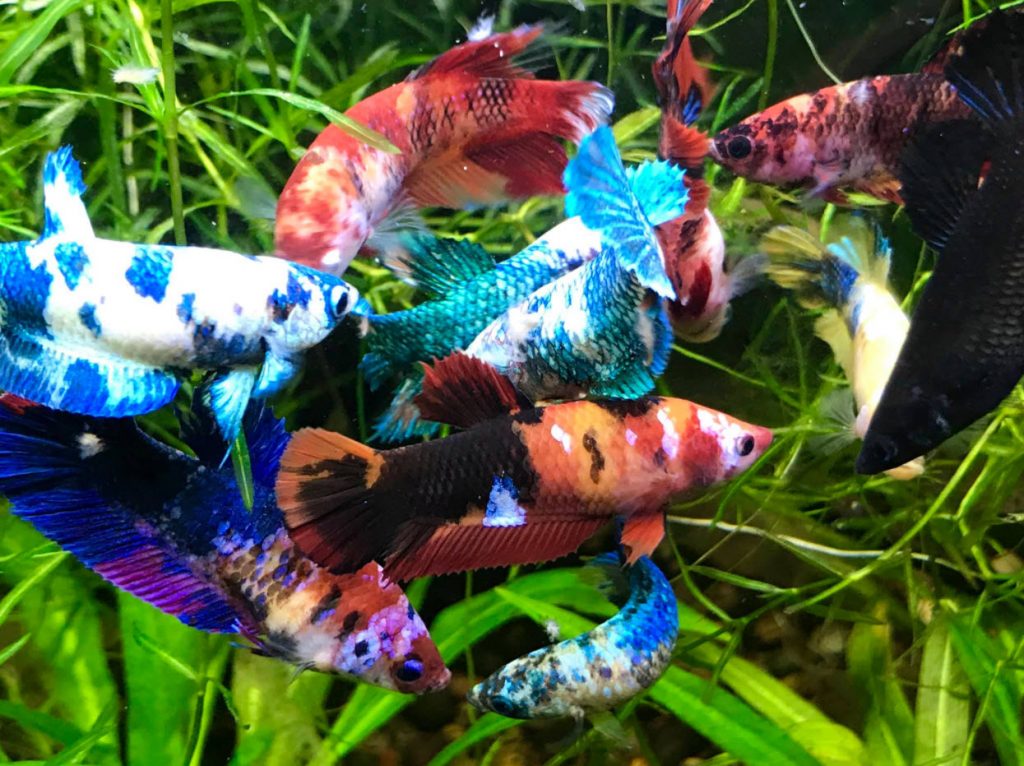
Female betta sororities have become somewhat of a “thing” in the hobby. It used to be all the females were drab fish with little color. But breeders have changed that to the point where some females rival the males in color. The betta females do not yet have the long flowing fins of the males but I suspect it will only be a matter of time before there are females available which are just as attractive as the males.
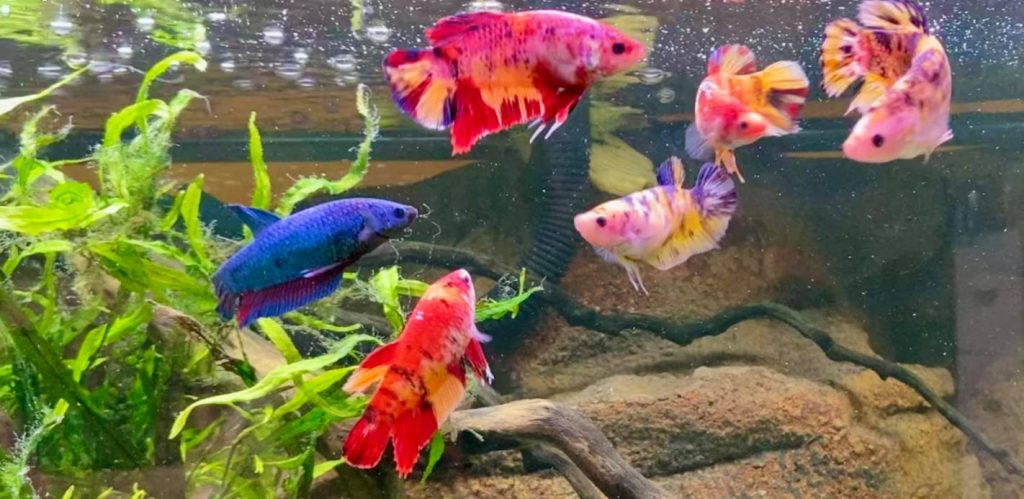
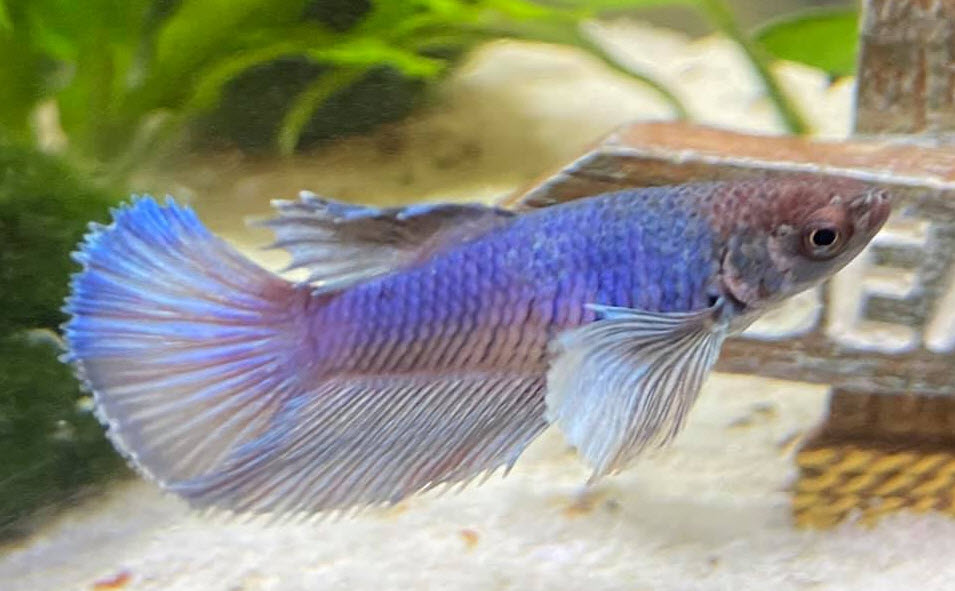
Bettas have been bred for fighting and for show for some one hundred years or so in Southeast Asia. They have been kept in small containers while doing this breeding without filtration or aeration. This “inadvertent selective breeding” has produced a fish which does very well in very small containers with very poor filtration and very poor aeration.
Now the long flowing fins and inbreeding of the modern betta have cut back on this immune system robustness to a certain degree but not eliminated it. This being said, we don’t advocate keeping ANY fish in water which doesn’t have some sort of filter in it, unless the water is frequently changed out.

Every day on social media one sees a photo of the “horrible conditions that the bettas in Petco live under”, namely being in transparent cups. This photo is always accompanied by a good bashing of Petco or the local fish store for the “appalling conditions” they keep fish in.
Newsflash: Bettas will do just fine in cups TEMPORARILY in the store IF the water is changed every two days or so and IF the store temperature is above 70 degrees. This practice is NOT inhumane in any way, contrary to all the passionate opinion expressed in social media.
Note we definitely DO NOT recommend making a betta survive in a cup of water on a permanent basis. But there is nothing wrong with a betta in even a half gallon of water if it has aeration, a heater and a filter.

Optimum Conditions for Bettas
A betta will be fine in a small half gallon betta tank in a home or office if some conditions are met:
- The temperature of the water needs to be above 700 F (210 C).
- There needs to be a cycled filter with a biofiltration media which is left uncleaned for months at a time.
Normally hobbyists want any fish to do as well as possible. Even though bettas are “easy”, creating the “best” conditions for them often is not easy. This is because they do best with very still water which is also bacteria free. They are native to very still water and their long flowing fins do not allow them to swim all that well against a current. They also breed with bubble nests and bubble nests do not do well in a current.
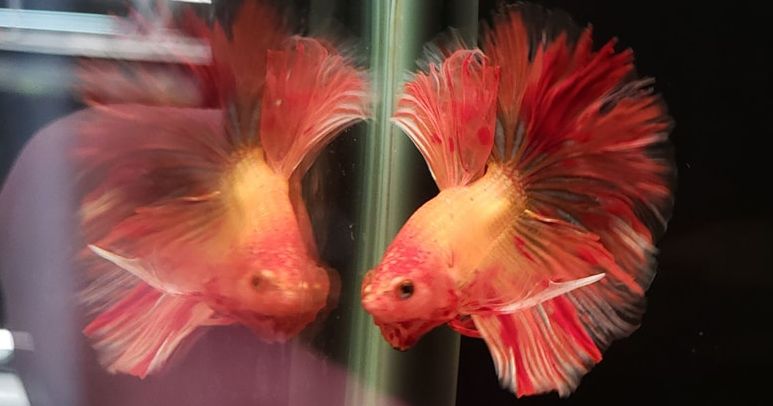
People think that bettas do not do well at any temperature below 780 F (25.60 C) This is a myth. The big problem with this myth is that “bad” bacteria love high temperatures. So bacterial infections such as fin rot are common in warm water. Bettas thrive in temperatures down to 70 degrees and can go down to 65 for days at a time with no damage. “Ideal” temperatures are 800 – 850 F. (270 – 290 C.), Quite acceptable temperatures are 700 – 900 F. (210– 320 C) with excursions to 650 – 950 F. (180 – 350 C).
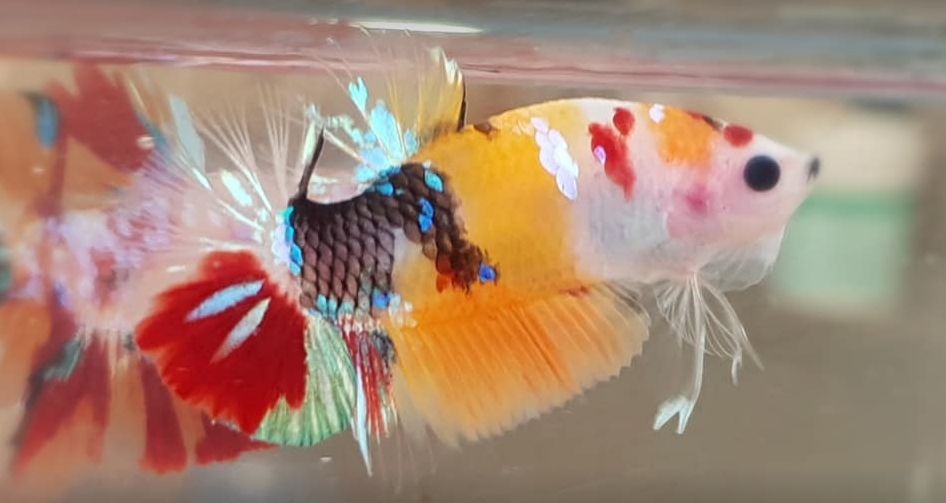
Bettas have been bred to have exceptionally beautiful long flowing fins. These unnatural fins have a big problem. They tend to get infected easily if they are in water which has a lot of “bad” bacteria in it. Water which is not well aerated tends to build up high numbers of “bad” bacteria. Water which is not moving tends to be water which is not well aerated. This creates a conundrum. How does one create well aerated bacteria free water which is also free of currents?
And “bad” bacteria grow far more abundantly in water which is not well filtered. Well filtered water typically means a current. And a current, especially in a small aquarium, will result in a betta hiding in a still water corner of the tank.
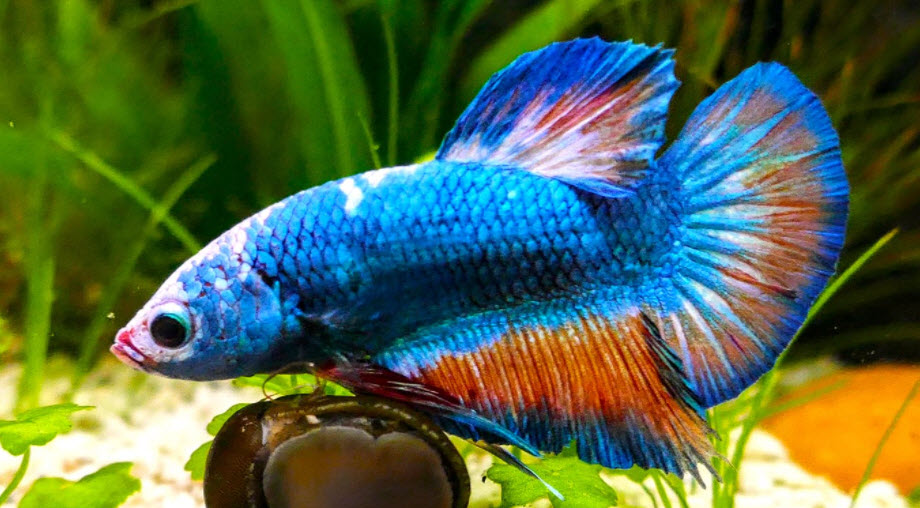
So still water for bettas is difficult to achieve with a good filter and good aeration. I recommend some unusual filtration with small aquariums and bettas.

A small sponge filter (I like the aquarium Co-op sponge filter) modified like this will give excellent oxygenation and excellent biofiltration with no current to speak of in the aquarium. This is great for any betta in a small tank. Just take a small thin water bottle, cut off the bottom, add some holes to the bottom, and set it up as shown. This is a great DIY filter for bettas. Paint the bottle any color you want if the colored pot scrubbers don’t look good to you. Note the pot scrubbers can be cut up to fit in the bottle.
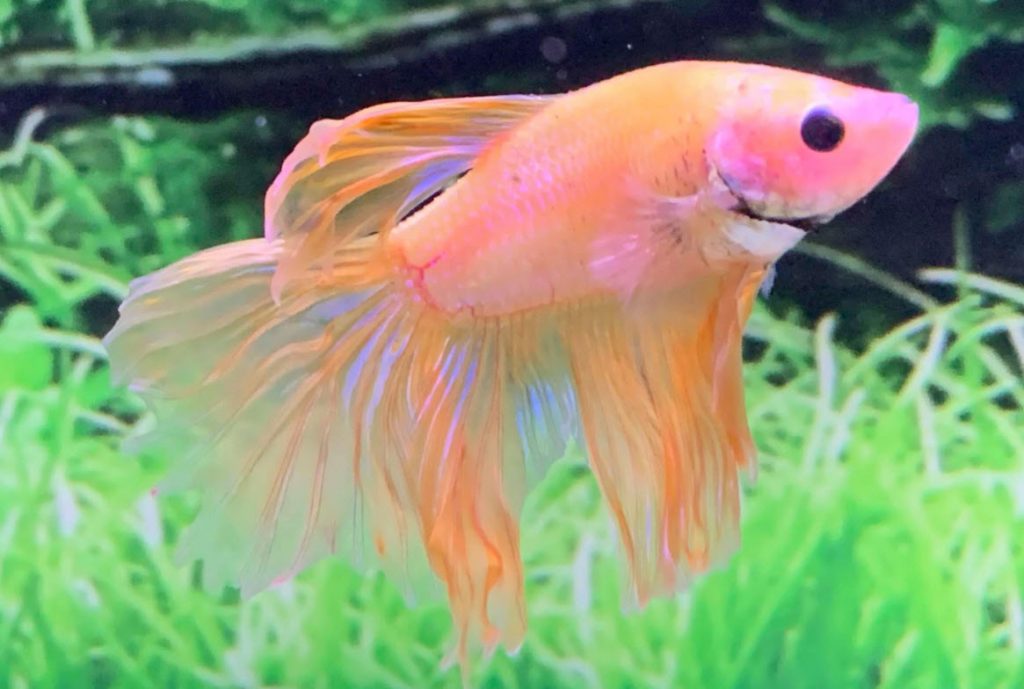
And another great option with bettas is an undergravel filter. Just use an inch or so of 1/8 th to 3/16 ths inch gravel (3 to 5 mm gravel) and never clean the gravel and the bettas will love it.
Prophylactic Treatment of New Bettas
New bettas do need to be prophylactically treated with medicated food as soon as they arrive at their new aquarium. The bettas have typically been through a lot and are stressed and typically have some bacterial infections going on. So we recommend prophylactic antibiotic treatment as soon as you get a betta.
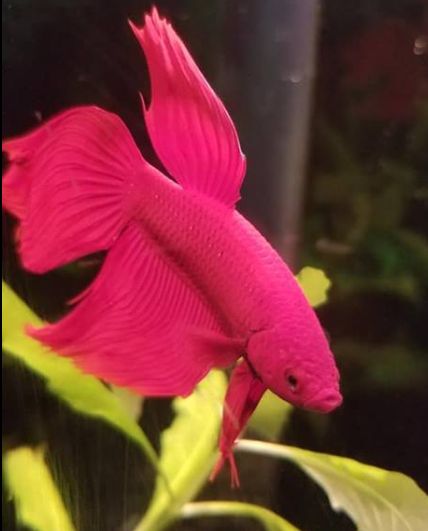
It is easy to make food which has been medicated with a broad spectrum antibiotic. Heat 1/4 cup water (two ounces or 58 milliliters, not a lot) in the microwave. Then blend one seven grams of plain animal derived gelatin (Knox gelatin, one packet) into the hot water with vigorous stirring. Take two tablespoons of dry commercial fish food (pellets or flake) and mix it with just a little of the hot water/ gelatin mixture. Add hot water/gelatin until you get a paste like consistency. If it gets too watery just add more food.
Then add roughly 1/16 teaspoon (a 1% to 2% addition) of a broad spectrum antibiotic to the mud. Mix and mash the whole mass thoroughly. Spread it out into a pancake about 1/8th inch (3 mm) thick on a plastic film or a plate. Then put in the refrigerator. If you plan on keeping it for more than two weeks put it in a small plastic bag and freeze. Feeding should be at least for a week.
This broad-spectrum antibiotic can be Thomas Labs Fish Mox, Midland Vet Service Aqua-Mox, VetDepot Amoxicillin, Fishbiotic Ampicillin, SeaChem KanaPlex, Mardel Maracyn 2, Thomas Labs Fish Min, or Thomas Labs Fish Doxy. This antibiotic can also be a human antibiotic pill such as Ciprofloxin or Amoxicillin. If it is in a pill form just crush the pill to a powder. Note human antibiotics are much stronger than fish antibiotics, so cut back the amount to just a “smidgen”.

Indian Almond Leaves
Many people passionately belief that Indian almond leaves are essential in the water of a betta aquarium. Newsflash, this is a scam perpetuated by a bunch of “researchers” and marketing folks in Thailand.
The only “science” backing the medicinal properties of Indian almond leaves is two, shall we say, “questionable” studies (“The in vitro Antibacterial Activity and Ornamental Fish Toxicity of the Water Extract of Indian Almond Leaves”, Chansue et al., 2008, “Potential Application of Extracts from Indian Almond Leaves in Siamese Fighting Fish Culture”, Purivirojkul 2012). Do a Google Scholar search for “Indian Almond Leaves Aquariums”, see for yourself, only two studies.
These two “research studies” were done in Thailand (where Indian almond leaves are grown… hmmmmm…wonder if there is a connection?). These “studies” “proved” a concentration of Indian almond leaves equal to a couple of bushels of leaves in a 50-gallon tank will inhibit bacterial growth. They also showed that that level of tannins will kill bettas. Lower levels of tannins such as would be found in an aquarium with reasonable quantities of Indian Almond leaves in it do not kill bacteria and do not benefit fish, BY THESE TWO STUDIES.
For more on this scam go to this link:
12.4.1. Natural Aquarium Medications
.
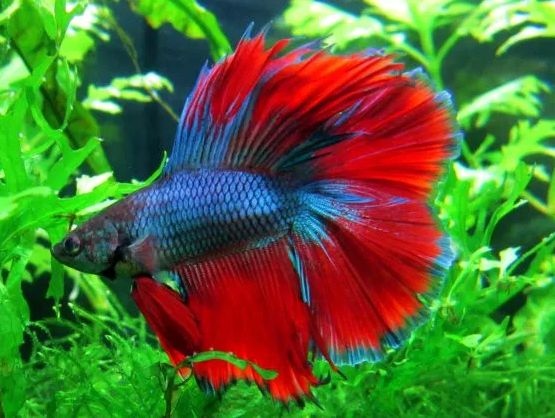
Betta Health
Note that “normal” wild bettas only live two to four years. The highly inbreed (brother being mated to sister repeatedly) modern bettas only live about two years. Bettas are commonly six months to a year old when purchased. So bettas get old and die fast. This is especially true if a male betta is constantly challenged through the glass with another male betta or its own reflection. This stresses the fish and constant stress will kill it early.
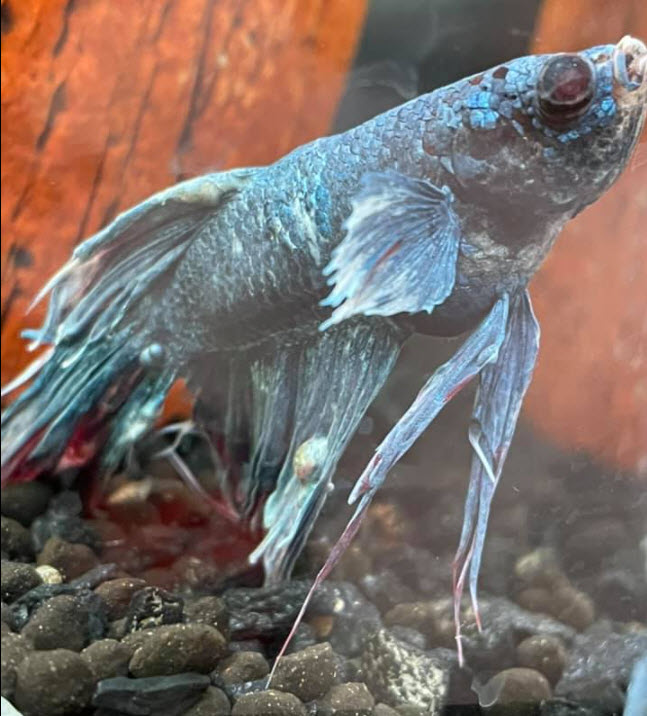
When bettas die from old age they tend to die very slowly, with all sorts of obvious physical ailments. There are constantly photos of obviously old bettas on social media with the question: “How do I cure my betta? I personally never answer such a question as the best answer is “euthanize the fish, he’s dying from old age“. And no one wants to tell a fish hobbyist to do that.
Betas also suffer from a host of problems that are related to the inbreeding that has occurred. There are many types of inbred bettas which are known by breeders to be a problem, with tumors, dropsy and swim bladder problems being very commonplace. But these breeds are very attractive when young and can be sold for high prices. So breeders keep breeding them.
And the breeds with shortened spines are especially prone to diseases. The newer breeds are just a short-lived fish in general. If you have a betta for more than two years you are really doing very well. “In beauty lies death”.
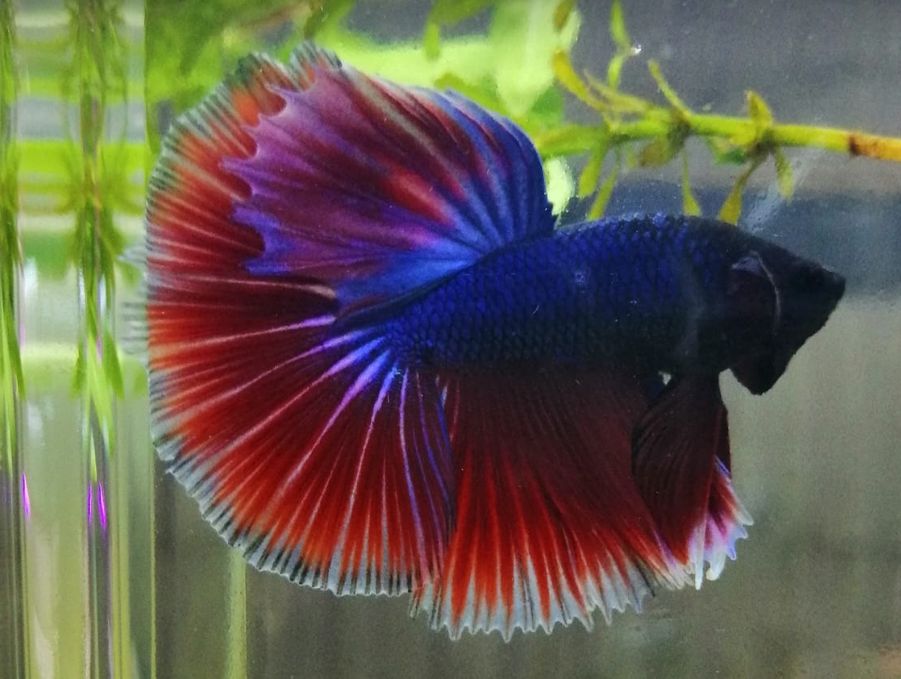
Graphite Disease
In bettas which have no red, yellow or orange pigments on their bodies (i.e. completely blue, black or white) there is a rare genetic predisposition to a rare type of rapid moving mycobacterium (“Fish TB”). It is called “graphite disease” and is very poorly studied. It is the subject of much misinformation. This rare disease is covered in more depth in this article:
10.16. Graphite Disease in Bettas

Tankmates
Bettas do decently well with other fish in larger community tanks. If they are in a small aquarium (under 15 gallons) there can be a problem with other fish. Sometimes bettas tolerate other fish in small tanks with them and sometimes they do not. So one can put a betta in a small aquarium with other small fish but it is risky.
There is another overlooked aspect of this relationship. In a small tank smaller fish cannot hide or get a “safe distance” away from a betta. The second fish will thus be constantly stressed even if the betta does not attack it. Constantly stressed fish get diseases and die young. So in an aquarium less than 15 gallons (60 liters) I recommend not add any tankmates for a betta.
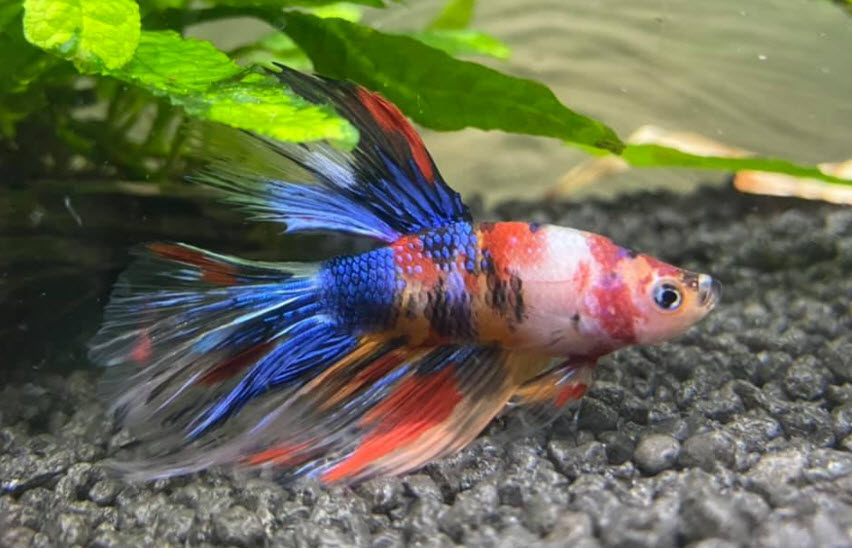
Back to Aquarium Size for Betta
Note that the PETA folks are fond of human analogies when talking about betas. They make comments like (this is an actual quote from Facebook):
“Putting a beta in a one gallon aquarium is like a human living in a car. One can survive but it is not a desirable condition”
Doing some simple math says that putting a betta in a one gallon tank is the same ratio wise as putting a human in a 218 square foot apartment (20 square meters). There are a lot of people living very happy lives in studio apartments that size. An automobile for a human is like a one pint (half a liter) of water in a betta aquarium. So the analogy of a car for a betta in a one gallon tank simply doesn’t hold water (pardon the pun).
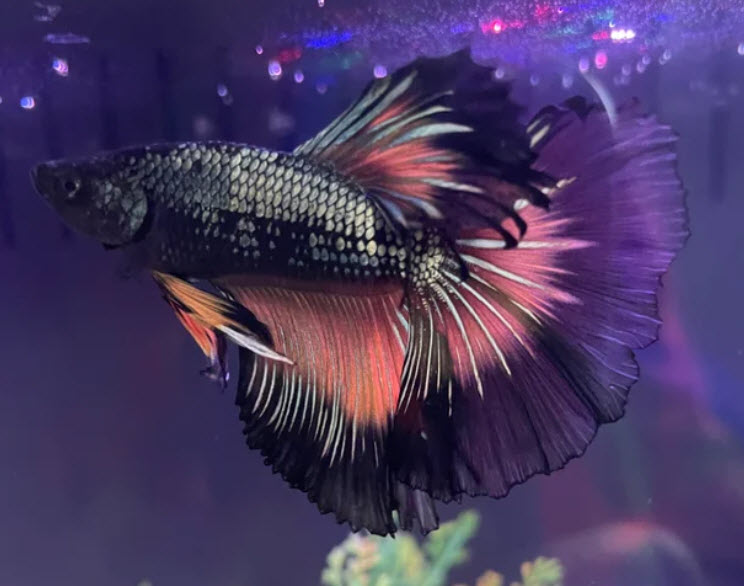
Belief Perseverance Effect
Note that we can state with absolute certainty that anyone who believes bettas needs a minimum of 5 gallons of water per fish and reads this article will absorb absolutely nothing from this article. All the information and data will simply bounce off like pebbles being thrown at a brick wall. They will rationalize and rationalize some more and reject the scientific evidence.
A quote from Tumbleweedtumbling is appropriate:
“Your response is precisely the kind of hysterical biased personal opinion that my entire article was about. You have no research to quote, no personal experiments and nothing to offer but your opinion. I advise you to go back and read what I wrote very carefully. Obviously you missed everything but your personal beliefs being challenges and you are unable to process that challenge or consider you just might be wrong.”
This is something called “belief perseverance effect”. It says that if someone believes fervently in something, even when presented with evidence they are in error, a normal person will rationalize and support their own decision. There is no point in trying to uses logic or science to change such a person’s mind, especially when dealing with a topic like what the humane treatment of a betta is.

This is just the world we live in and there is no point in trying to fight it. Every time this article is posted in social media someone comes on to say how horrible this article is and that the author is an idiot. LOL

Return to Fish Selection Menu
.
Aquarium Science Website
The chapters shown below or on the right side in maroon lead to close to 400 articles on all aspects of keeping a freshwater aquarium. These articles have NO links to profit making sites and are thus unbiased in their recommendations, unlike all the for-profit sites you will find with Google. Bookmark and browse!
.

Dave says
In reply to Jorge ….. Bettas are a short term fish. They tend to only live two to three years. So it is not unusual for one to just die for no apparent reason. It had nothing to do with the temperature. I’m assuming you adequately cycled the tank in it’s new location??????
JORGE BALLINA says
I HAVE MY 3 MIKES IN A WATERFALL TYPE TANK…3 CHAMBERS, CURVED, FILTERED, ETC…I’VE ONLY HAD THIS SETUP FOR A YEAR BUT 2 WEEKS AFTER MOVING INTO MY NEW PLACE, MICHAEL JACKSON DIED…ITS A BIT COLDER, 75ish, BUT THEY CAME FROM MY 80+° BATHROOM…HE WAS A FAT BOI, PROLLY OLDER, ABSOFUCKINLUTELY GORGEOUS, & NOW HES GONE…IVE HAD THESE FISH MY WHOLE LIFE…ANYONE GOT ANY INPUT?? SAME DIET, ONLY CHANGE WAS TEMP….MICHAEL JORDAN & MIKE TYSON ARE GREAT…I HOWEVER, AM NOT…JACKSON WAS THE MOST HANDSOMEST BETTA EVER.
MOSTLY WHITE, PINK, & FLAMBOYANT AS FUCK, WITH HIS BIG HANDSOME FINS…SUCH A SHOWMAN. Y’ALL KNOW…I AM SAD. BOUT TO GET THIS PRETTY LIL MOONTAIL TOMORROW CUZ I CANT HAVE AN EMPTY SPOT. IN THE TANK OR IN MY HEART.
Dave says
In reply to JL … Until one can give me a study which show constipation occurs in bettas in small tanks (with controls, etc.) my recommendation stands firm. There is no research on ANY fish which indicates exercise is beneficial. NONE! Anthropomorphism is the common practice of assigning human characteristics to animals and it is NOT valid. Indeed, as an old back packer I can testify that in humans exercise often results in constipation (i.e. “compacting”).
JL says
Dave, I’m going to challenge you on your opinion that a 1/2 gallon for bettas is sufficient. My main reasoning for this is bettas get constipated so easily living on dry food, tha most popular of betta foods. Constipation causes bloat, which can lead to swim bladder disease. Chronic constipation also puts a lot of strain on the kidneys, which leads to organ failure. My opinion is that bettas should have the opportunity to exercise to deal with this constipation. Most fish keepers of small aquariums will not give bettas the diet and necessary stimulation to help their bettas have a good digestion system. A bigger aquarium gives the opportunity for exercise and stimulation to happen more passively, leading to a healthier fish.
JL says
Barbara, I live in Alberta and I can get Kanaplex (Kanamycin is the active ingredient) through Amazon and Ebay. Do you live in Ontario? I’ve heard people in Ontario having a hard time getting fish antibiotics. Hopefully, you have a friend elsewhere that can order and send it to you.
Barbara Andersen says
I live in Canada where, as here say would have it, antibiotics for fish are not available from aquatics suppliers and they cannot be imported from the US/elsewhere. Further, human antibiotics must be prescribed by a doctor after diagnosis of such need, thus causing me to ponder whether there are other options or if one can skip the treatment of new fish and reasonably hope for the best. Gratitude for any such, thank you.
Dave says
In reply to Mary ….. Sounds good to me.
Mary says
I am starting a betta sorority at present, 4 female bettas in a planted 29 gallon tank. I keep temp at 80°F..I have 2 oversized tidal HOB filters, that I have dialed down to just a trickle. It seems to be working. I’ll be adding some Pygmy Cory’s, and perhaps some Cherry shrimp (so the girls can hunt). Any other suggestions?
Mandy says
I’m so glad I came across this article. I’m new to this world of fish keeping and have been looking for general basic advice and have come across some unhinged individuals especially on some social media pages and forums. Thanks v much.
Dave says
In reply to Alex … Yes the pot scrubbers can be replaced by 20 ppi foam. And the air collar seems to work very well so I would continue to recommend the Co-op sponge filters.
Alex says
Hi Dave. Do you think wrapping a prefilter sponge around the lift tube of a sponge filter would have the same effect as the plastic bottle & pot scrubbers in your DIY filter to minimize flow, as long as the lift tube is long enough (e.g., extended with an extender)?
Also, Aquarium Co-op seems to have changed the design of their filter, where they “included an air collar that replaces the need for an air stone and minimizes bubbles coming out of the side of the sponge”. Would you still recommend their sponge filter?